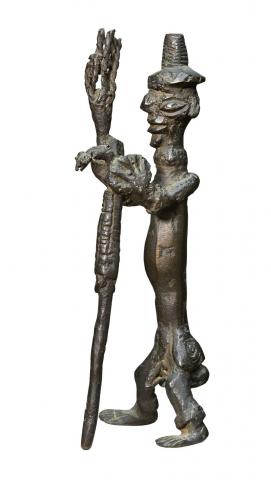STANDING WARRIOR, c.1939
DONALD FRIEND
bronze
20.0 cm height
Donald Friend Retrospective, Art Gallery of New South Wales, Sydney, 9 February – 25 March 1990; National Gallery of Victoria, Melbourne, 14 April – 6 June 1990; and Tasmanian Museum and Art Gallery, Hobart, 26 June – 19 August 1990
Pearce, B., Donald Friend, 1915–1989: Retrospective, Art Gallery of New South Wales, Sydney, 1990, cat. 9, p. 35 (illus.)
Friend's African manuscript indicates that he researched the history and techniques of Benin bronze work of Nigeria quite extensively, and these small sculptures cast through the lost-wax method reflect his interests of the time. The Yoruba people of Ikerre were known particularly for their beautifully carved fetishes, a number of which Friend collected, and which became amongst his most cherished possessions. However he deplored the vulgarisation of the ancient crafts of West Africa and hoped that they might be revived through new designs: 'The brassworkers now turned from the making of plaques which they had lost the skill to produce, to making stiff and stilted copies of the old heads - poorly cast affairs with mounds of ornamental headdress dwarfing the little simple face depicted with salutary negligence. And then ashtrays - the final degradation - and putrid petty knicknacks that Hausa [British soldiers] men hawk all over the country for a few bob a time. These find a fairly ready market among the Europeans, who, having at last reduced an art to trash, like it that way. This is a depressing history to give. Yet there is hope for a rebirth of craft and new designs.'1
1. Pearce, B., Donald Friend, 1915-1989: Retrospective, Art Gallery of New South Wales, Sydney, 1990, p. 35
